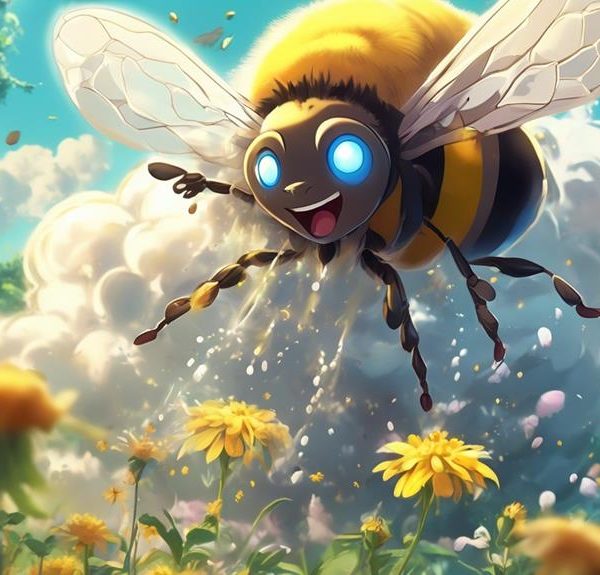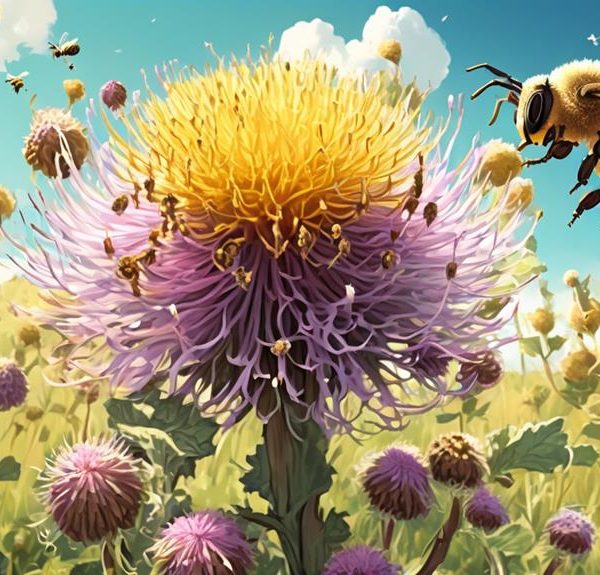Witness the fascinating relationship between bees and bugleweed, an unfolding secret that garden lovers and beekeepers alike will find intriguing.
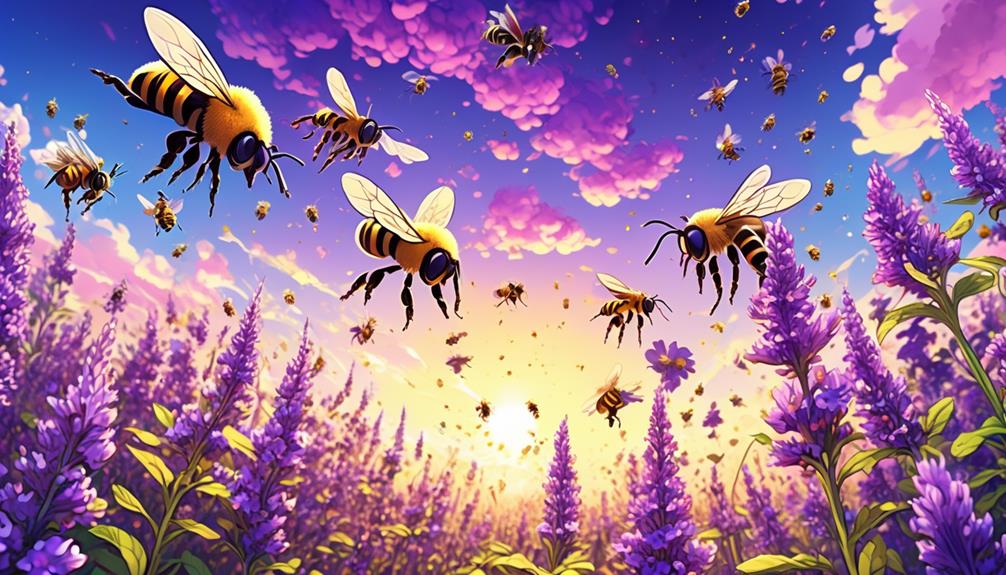
Do Bees Like Bugleweed
As you sit in your garden, observing the busy bees buzzing around your vibrant flowers, you may find yourself questioning their preferences. Among the plants they visit, bugleweed stands out with its sprawling green leaves and clusters of purple flowers.
But does this plant really hold a special allure for these hardworking pollinators? It's a question that you, along with many garden enthusiasts and beekeepers alike, might have pondered over.
In order to answer that, we need to unravel the intricate relationship between bees and bugleweed, and that might lead you to some surprising discoveries.
Key Takeaways
- Bees are attracted to bugleweed due to its vibrant purple-blue flowers, high nectar yield, and secure landing pads.
- Bugleweed's native status and blooming period align with the active season of local bees, creating a mutualistic relationship.
- Bugleweed provides a consistent food source for bees with its flowering schedule and impressive nectar production.
- There are bee-friendly alternatives to bugleweed, such as lavender, borage, and sunflowers, that offer both aesthetics and functionality for supporting bee populations.
Understanding Bees' Plant Preferences
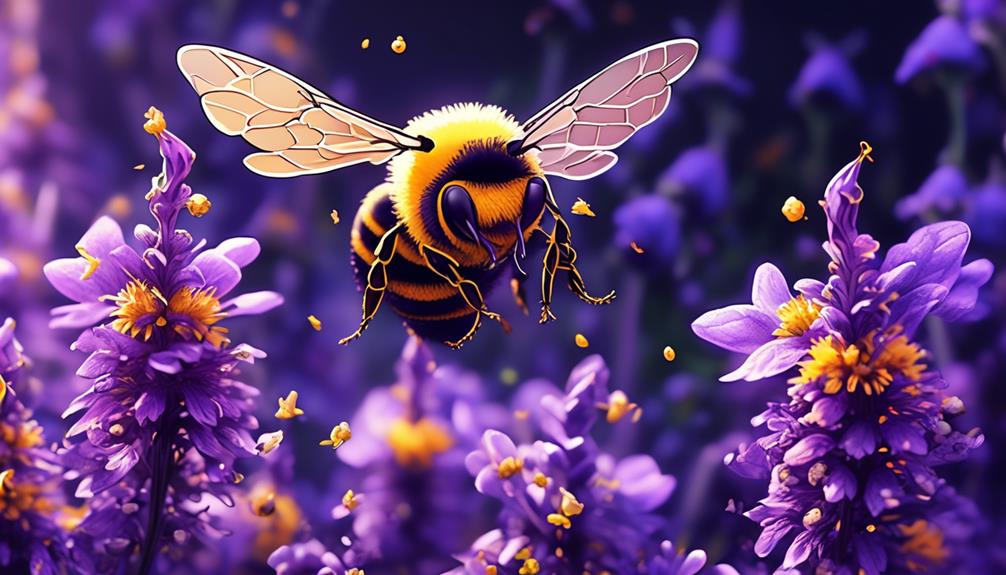
To comprehend bees' plant preferences, it's crucial to delve into their innate attraction to certain types of flora, such as the bugleweed. This perennial plant, known scientifically as Ajuga, boasts vibrant purple-blue flowers that are a visual feast for bees. But it's not just the captivating color that draws bees in.
Bees are enticed by the plant's high nectar yield, which serves as a prime food source for these industrious insects. The bugleweed's funnel-shaped flowers also provide a secure landing pad for bees, facilitating effective pollination.
Moreover, you should note that bees exhibit an inherent preference for native plants over exotic ones. They've co-evolved with local flora, resulting in a mutualistic relationship that benefits both parties. As such, bugleweed, native to Europe, may attract more bees in its natural range compared to non-native regions.
In understanding bees' plant preferences, you're not just deciphering the ecological dynamics of pollination. You're also gaining insights into how to better conserve these essential pollinators. By favoring plants like bugleweed in your garden, you're providing bees a much-needed habitat and food source, ultimately contributing to their survival.
The Allure of Bugleweed
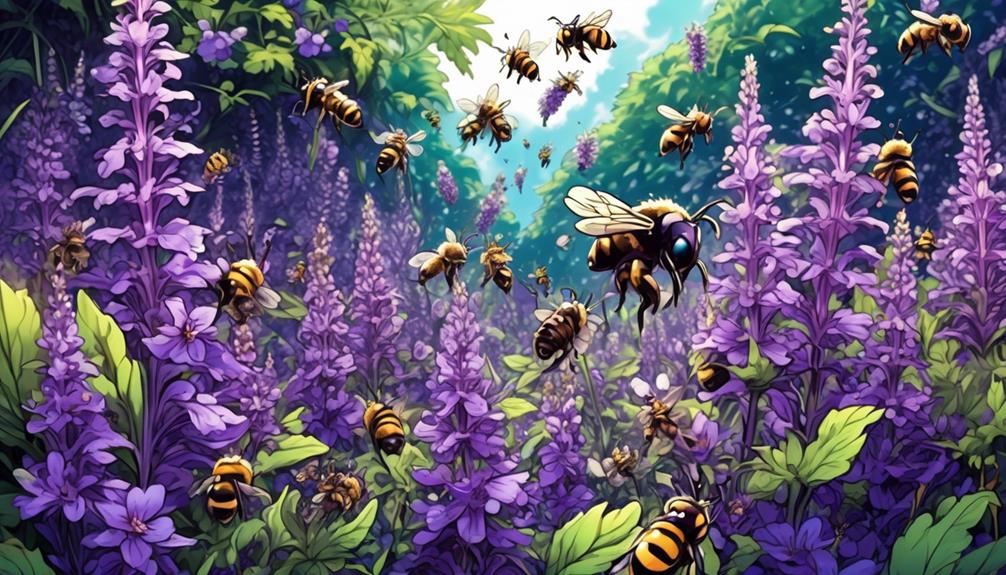
Diving into the allure of bugleweed, you'll find that its vivid hue, high nectar production, and native status make it a prime attraction for bees. This perennial ground cover, also known as Ajuga, boasts vibrant blue-violet flowers, a color spectrum that particularly appeals to bees. Its intense color signals a rich source of nectar, a primary food source for bees, which they use for energy and to make honey.
Bugleweed's high nectar production further enhances its appeal. It's a prolific nectar producer, pumping out copious amounts of this sweet substance, especially during late spring and early summer. This is when bees' nectar needs peak, as they're busy foraging to feed their growing colonies.
Lastly, as a native plant, bugleweed has co-evolved with local bees, leading to a deep-rooted mutual relationship. This native status means its blooming period aligns perfectly with the local bees' active season, and its flower structure suits the bees' body shape and foraging habits. Therefore, you can't ignore the fact that bugleweed's allure for bees is a combination of its striking visual appeal, generous nectar offering, and perfect timing.
Investigating Bugleweed's Bee Appeal
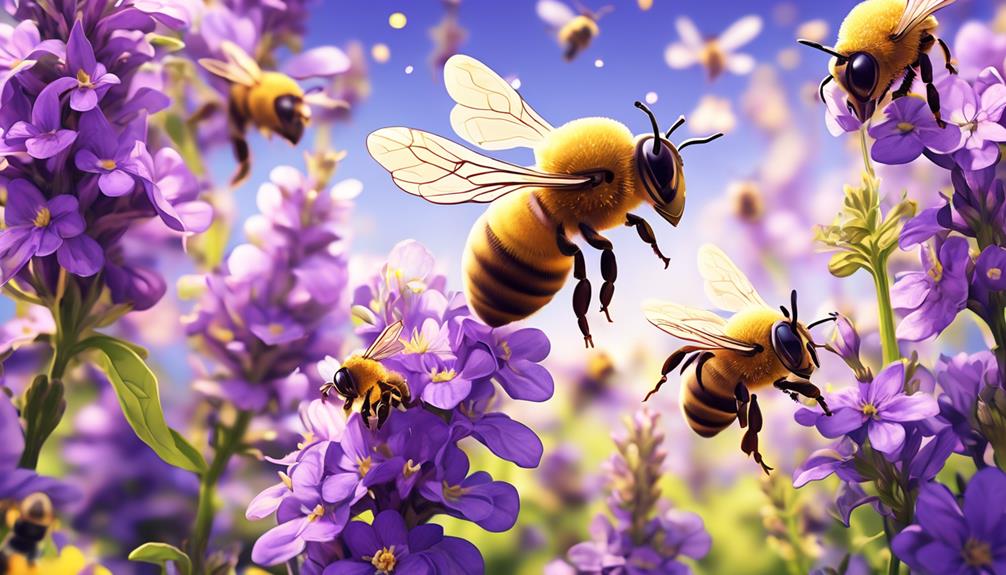
Let's delve into an examination of bugleweed's undeniable appeal to bees, analyzing the intricate synergy between this plant's flowering patterns, nectar production, and color spectrum, and the bees' foraging behavior.
This plant's flowering schedule aligns with the bees' active periods, ensuring a consistent food source. The bugleweed's nectar production is impressive and the quality, particularly high in essential sugars, is a bee magnet.
Take a closer look at the plant's color spectrum. Bugleweed's vibrant blue-purple hue falls within the bees' color perception range, making it highly visible to them. This color, in the ultraviolet spectrum, is a strong signal to bees, often associated with rich nectar sources.
Now, consider the bees' foraging behavior. Bees tend to forage in areas where food sources are abundant and reliable. Bugleweed, with its prolific flowering and nectar production, fits this criteria perfectly. Moreover, the plant's dense growth pattern provides a sheltered environment for bees, further enhancing its appeal.
Bee-Friendly Alternatives to Bugleweed
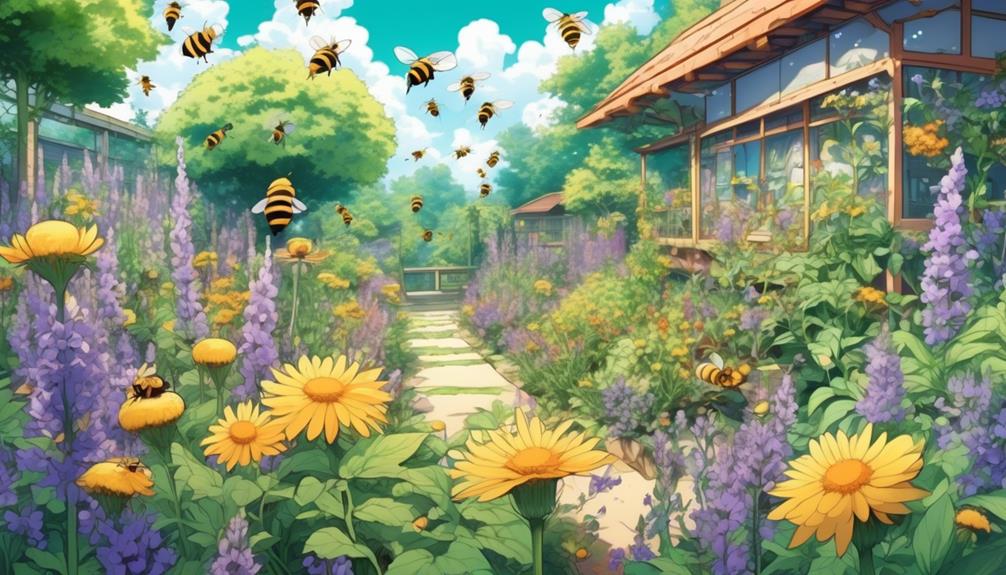
While bugleweed certainly stands out for its bee-attracting qualities, there are other plants you might consider that are equally, if not more, conducive to supporting bee populations. If you're interested in creating a bee-friendly environment, you'd do well to explore other options.
Consider the following alternatives, which offer a blend of aesthetics and functionality:
Plant | Bloom Season | Bee Attractiveness |
|---|---|---|
Lavender | Summer | High |
Borage | Spring to Fall | High |
Sunflower | Summer to Fall | High |
Lavender is a fantastic choice due to its prolonged bloom time and high nectar production. Bees are particularly attracted to its scent and vibrant colour. Borage, on the other hand, has the advantage of continuous blooming from spring to fall, providing bees with a constant food source. Its star-shaped flowers are a visual treat too. Lastly, sunflowers, with their large, nectar-rich heads, are a bee magnet in the summer and fall.
Enhancing Your Garden for Bees
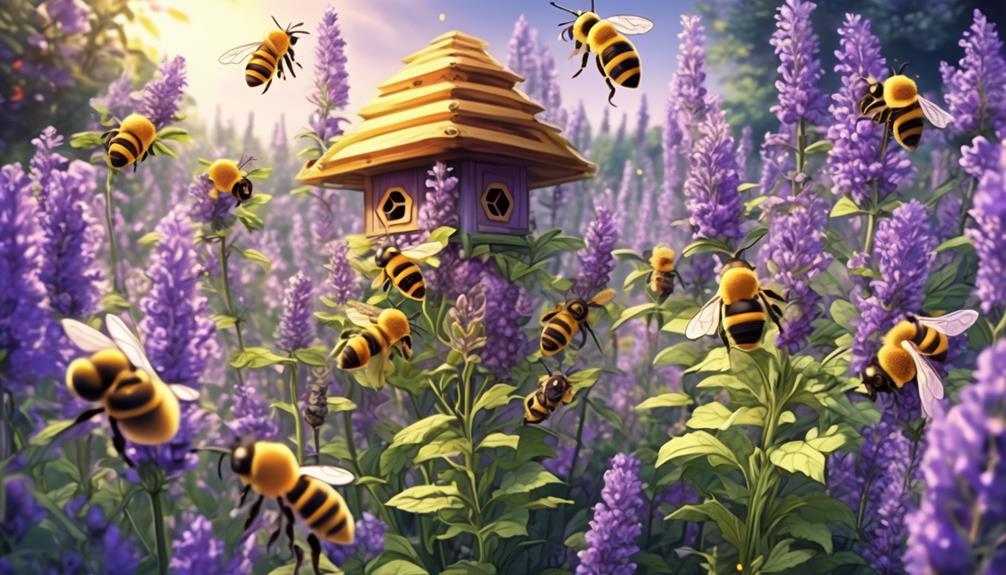
To enhance your garden for bees, you'll need to consider factors such as plant diversity, water sources, and providing shelter, each playing a critical role in supporting and attracting these vital pollinators.
A diverse mix of flowering plants, particularly native species, allows bees to access a range of nectar and pollen sources throughout the year. This diversity also aids in the health and longevity of the bee population, by reducing the risk of disease spread through monocultures.
A steady water source is crucial for bees, as they use it for hydration, cooling their hives, and diluting stored honey. A shallow dish with pebbles or twigs for landing spots works well.
Providing shelter for bees is also vital. Some species nest in the ground, while others prefer cavities in wood or hollow stems. Leaving some areas of your garden undisturbed and providing bee houses can create much-needed habitats.
Avoiding the use of pesticides is another essential step. These chemicals can be harmful, even lethal, to bees. Opt for organic gardening practices wherever possible.
Frequently Asked Questions
How Does the Bugleweed's Growth Cycle Affect Its Attractiveness to Bees?
You're probably wondering how the bugleweed's growth cycle impacts its appeal to bees. Well, it's all about timing.
As bugleweed blooms, it produces nectar and pollen that attracts bees. However, if the plant's blooming period doesn't coincide with the bees' active season, it's not as attractive.
It's crucial that the bugleweed's growth aligns with when bees are foraging to ensure it's a desirable food source.
Are There Specific Types of Bees That Are More Drawn to Bugleweed?
Yes, there are specific types of bees more attracted to bugleweed. It's typically honey bees and bumble bees that are drawn to this plant.
The nectar and pollen provided by bugleweed's small, tubular flowers are an excellent food source for these bees.
However, it isn't just about food. These bees also find the dense, low-growing habit of bugleweed ideal for nesting and shelter.
What Other Insects Are Attracted to Bugleweed, Aside From Bees?
You're inquiring about other insects attracted to bugleweed apart from bees. Butterflies, moths, and certain beetles find bugleweed particularly inviting. Its vibrant flowers and enticing scent draw them in.
Additionally, hoverflies, known for their bee-like appearance, are also frequent visitors. However, the plant's appeal doesn't stop there.
Bugleweed's dense foliage provides a perfect hideout for spiders and other small creatures. It's truly a bustling hub for a diverse range of insects.
How Does Bugleweed Compare to Other Plants in Terms of Its Nectar Production?
You're wondering how bugleweed stacks up against other plants for nectar production.
Well, it's not the top producer but it's certainly not the lowest. It churns out a moderate amount of nectar, enough to attract various pollinators.
However, compared to nectar-rich plants like lavender or sunflowers, it's a bit on the lower side.
It's more about the total package with bugleweed – its foliage, growth habit, and bloom time all contribute to its appeal.
Can Bugleweed Be Harmful to Certain Species of Bees?
No, bugleweed isn't harmful to bees. In fact, it's quite the opposite. You'll often find bees buzzing around bugleweed because it's a rich source of nectar. This plant isn't toxic to bees and doesn't contain any substances harmful to them.
Conclusion
So, do bees fancy bugleweed? While they're not particularly drawn to it, they won't shun it either.
Bugleweed's nectar and pollen can sustain bees, but there are other plants they prefer more. If you're keen on creating a bee-friendly garden, consider diversifying with other bee-attracting plants.
Remember, the key is to provide a variety of blooming plants throughout the season to support our buzzing friends. After all, fostering a bee-friendly environment is crucial for our ecosystem.

